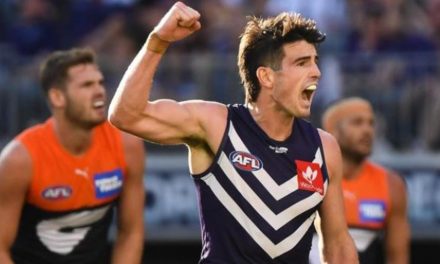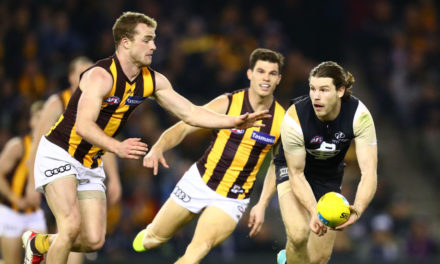Gary Ablett senior marks between Bombers Derek Kickett and Chris Daniher during his famous 14-goal haul in 1993.
This may sound hypocritical coming from a nostalgic old fool such as myself, but football needs to stop looking in the rear vision mirror. The obsession with recapturing the high scoring footy of the 1970s, 80s and 90s is misguided on a number of counts.
Pining for the past goes hand in hand with being critical of the present. AFL today showcases the game’s skills like never before. Spectacular high-marking, pinpoint kicking with both feet and ferocious tackling add up to a sport that still captivates nearly all that are exposed to it.
Think of the stars of the game today and what they are able to achieve. Aerialists Jeremy Howe and Liam Ryan can soar above an opponent and complete a mark as well as any other player in the history of the game. They are not alone, either. Think Nic Natanui, Josh Bruce, Jack Reiwoldt, Jamie Elliott and Chad Wingard, to name a few.
The game continues to produce on-ballers who will rightly one day take their place in the pantheon of football greats.
We will tell our grandchildren that we saw the likes of Gary Ablett junior, the Patricks Cripps and Dangerfield, the great Collingwood star Scott Pendlebury and the unstoppable tattoo artist’s canvas, Dustin Martin. And it wasn’t just on our handheld devices either. We’ll boast of actually seeing those legendary figures up close when we were at the game.
Just as night follows day and a reprimand follows any reportable act committed by the above mentioned stars, the modern game that we lambast so quickly will itself be fondly remembered as the good old days in a decade or two.
The fact is that the human brain is wired to filter out bad memories whilst simultaneously recalling those experiences we have enjoyed.
Just think of an overseas trip you may have taken some years ago. I wager that when you close your eyes all you can see is the sunset from that tropical island resort or taste the home-made gnocchi from that gorgeous little trattoria in Rome that you and your better half discovered completely by accident.
I am equally confident that less happy memories of delayed flights, queuing to see underwhelming tourist attractions and paying exorbitant “tourist” prices for food and drink have been well and truly suppressed.
So it is with football and those good old days.
Close your eyes and you’re at the MCG in 1993 watching Essendon take on Geelong. The sun’s shining, you’ve got the best seat in the house and even the half-time meat pie is the right temperature.
What a game! Essendon win by four goals, 23.18 to Geelong’s 19.18, but that’s not the half of it. Paul Salmon kicks 10 goals for the winners, whilst at the other end the great Gary Ablett senior boots a lazy 14 for the beaten Cats. It’s the greatest shootout between spearheads in the history of the game.
What wonderful memories. One thing’s for certain, you wouldn’t have such fond memories if you made a flying visit to Moorabbin Oval a few years earlier to watch the Saints take on the Hawks.
The home team kicked just four goals for the entire match, and whilst it was played in heavy rain, it didn’t stop Hawthorn, which won by 104 points. It was a miserable day, cold as a mother-in-law’s kiss and further ruined when the only men’s toilet on the members’ side of the ground packed it in just before quarter-time.
Memory isn’t just selective. It’s also age sensitive. Many of our fondest memories of watching football date back to our childhood. We recall them today as adults and when we recount them rarely acknowledge that they go back when we were 12 or 13 or in some cases even younger.
Childhood memories tend to be uncomplicated and either overwhelmingly positive or tearfully negative.
In the case of my early footy memories, and most likely yours, it was all positive. I can remember a sport played by powerful men who could kick the ball a country mile. Rough justice was dished out on field by players who took the role of hero or villain depending which side you followed.
It was a great day out, exciting, frightening and fun all rolled into one, and to top it off, it came with a hot-dog and a can of fizzy drink. Life didn’t get better than that.
As children, we went to the footy and all we saw was the game. We weren’t concerned about money and outside influence, we didn’t complain about the aesthetic, because we had no idea that such a concept existed. The world hadn’t spun its “magic” on us yet, so were still devoid of cynicism and scepticism. We were easily pleased and found footy pleasing.
Comparing football today to the game “back then” without allowing for selective and/or childhood memories is misguided when done by football fans, but becomes problematic when it’s our administrators who are party to the folly.
Egged on by equally nostalgic commentators, our game’s custodians are forever tinkering with the rules in an effort to recapture the game as played during the golden years of AFL football.
When those years actually were remains open to discussion, but like a dog chasing its tail, the law-makers and head honchos at AFL house continue to search in vain for the perfect football aesthetic.
A truckload of rule changes haven’t had the desired effect. Not only do they not work, they trumpet the notion that the modern game is in ill-health and needs curing.
Maybe what’s required isn’t a raft of rule changes to improve the game, but simply a paradigm shift. Let’s try celebrating what we have rather than constantly trying to recreate a past that only partly existed.
It would eliminate the confusion and subsequent frustration felt by fans who cannot and actually should not have to keep abreast of the constant amendments that are being made to the game. It would also give umpires a chance to improve their decision-making skills by allowing them to operate with the same rules for a sustained period.
Finally, and most importantly, when we change the way we view the modern game, we will have a greater regard for the elite athletes who go out there every week and put their bodies on the line in pursuit of four premiership points.











